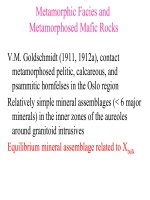Metamorphic rocks 10
Bạn đang xem bản rút gọn của tài liệu. Xem và tải ngay bản đầy đủ của tài liệu tại đây (9.3 MB, 52 trang )
Metamorphic Rocks
Metamorphism and Metamorphic Rocks
•
•
•
•
•
•
•
•
What is metamorphism?
How do temperature and pressure change rocks?
Are fluids important in metamorphism?
How are metamorphic rocks brought to the surface?
What are the conditions of metamorphism?
How are metamorphic rocks classified?
What was the rock before it was metamorphosed?
Where does metamorphism occur in relation to plate tectonics?
Metamorphism and Metamorphic Rocks
Metamorphic rocks:
• Form beneath Earth’s surface (metamorphic processes
cannot be directly observed).
• Are commonly found exposed in actively forming
mountains, e.g. the Himalayas today.
• Are always found in the centers of eroded ancient
mountain belts.
• Metamorphic minerals make up such economic materials
as talc, graphite, marble, garnet, corundum, and coal
deposits.
Metamorphism and Metamorphic Rocks
Preview: Three types of metamorphic rocks:
– Regional metamorphic rocks.
• Occur across vast regions such as convergent plate
boundaries (e.g. interior of Himalayas today)
• Increased temperature and directed pressure
– Contact metamorphic rocks.
• Thermally driven, common along boundaries of igneous
intrusions, sometimes under lava flows
– Hydrothermal metamorphic rocks.
• Produced by hot-fluid induced chemical changes
• May be associated with one or both of the previous types
Appalachian Mountains
- A belt of regional metamorphic
rocks >1500 km long and
200-300 km wide, produced
by continent-continent
collision.
From the Greek “meta” (change) and “morphe” (form)
Metamorphic rocks – Formed under conditions between those
of compaction and cementation (lithification – sedimentary
rocks) and melting (igneous rocks).
What is Metamorphism?
•
•
•
•
Metamorphism describes the mineralogical, chemical, and textural changes to
preexisting rocks due to increased temperature and pressure.
Metamorphic reactions occur in the solid state – no melting is involved.
Because these conditions occur at depth in the Earth, they are not directly
observable.
Modern experimental petrology, however, can reproduce these conditions in the
laboratory, including original rock, T, P and fluids.
Migmatite – formed by very high grade metamorphic
conditions where partial melting (anatexis) occurs.
What is Metamorphism?
•
Rocks exhibit two types of change:
• Original minerals react to form new minerals.
• Rock texture is altered by changes in size, shape, and
orientation of the minerals (new and/or old).
•
Original rock type is important:
• Chemistry controls what reactions will take place, i.e. what
new minerals may form.
• In general the whole rock starting composition is the same,
or similar to, the metamorphic rock composition.
• In some cases the presence of chemically active fluids
may cause substantial changes.
How do temperature and pressure change rocks?
•
•
We know: Temperature increases with depth in the Earth.
o
o
This is referred to as the geothermal gradient, typically 20-30 C/km beneath continents and 60 C/km beneath oceans.
How do temperature and pressure change rocks?
How do temperature and pressure change rocks?
• It takes ~10-12 km burial to reach low-grade metamorphic conditions.
• By contrast, lithification to form sedimentary rocks occurs at shallow depths.
How Are Higher Temperatures and Pressures Produced in Mountain Building Events?
• Mountain building
events involve
directed pressure, e.g.
the collision between
India and Asia
producing the
Himalayas.
• When one block of
crust is forced over
another along a fault,
the lower one heats to
a temperature
associated with its
new depth.
•This is referred to as
tectonic burial and
produces regional
metamorphic rocks.
How Are Higher Temperatures Produced by Magma Intrusion?
• Intrusion of magma
raises the local
geothermal gradient.
This causes
metamorphism in
rocks adjacent to the
intrusion.
• This produces what
are called contact
metamorphic rocks.
How do temperature and pressure change rocks?
•
Heat drives off fluids (volatiles) that may have been in the rocks.
• High-temperature metamorphism causes minerals
containing volatiles to lose them.
Dehydration reactions = loss of water.
(HEAT)
KAl3Si3O10(OH)2 + SiO2
(muscovite)
(quartz)
Al2SiO5 + KAlSi3O8 + H2O
(sillimanite)
(K-feldspar) (water)
How do temperature and pressure change rocks?
•
Minerals have ranges of temperature and pressure in which they are stable.
– If the T and P change the minerals may transform into new
minerals which are stable in the new conditions.
A Contact Metamorphic Reaction:
A Common Example We All Know:
~40 km
How do temperature and pressure change rocks?
•
Minerals have ranges of temperature and pressure in which they are stable.
– If the T and P change the mineral may transform into a new
mineral which is stable in the new conditions.
We can use metamorphic
minerals as indicators of T and P,
since we know what conditions
they are stable at.
Phase diagrams like this have
been constructed via
experimental petrology.
Kyanite: high P
Sillimanite: high T and P
Andalusite: low T and P
What if we found a rock with all
three minerals in it?
How do temperature and pressure change rocks?
•
Pressure can be simply thought of as applying stress to a rock.
• Stress – The magnitude of the force divided by the
area the force is applied to.
• Normal stress – perpendicular to the surface. Results
in change in volume and often shape.
• Shear stress – force parallel to the surface. Results in
change of shape, but not volume.
• Strain – the deformation of a rock as a result of
applied stress.
How do temperature and pressure change rocks?
Directed pressure such as this is called Differential Stress.
How do temperature and pressure change rocks?
How do temperature and pressure change rocks?
•Directed pressure can cause platy minerals such as micas to
align perpendicular to the stress.
• This produces what is called foliation and is a characteristic
of regional metamorphic rocks.
How do temperature and pressure change rocks?
Foliation in thin section: Defined by alignment
of muscovite (brightly colored) intergrown with
quartz (greys and blacks)
How do temperature and pressure change rocks?
Metaconglomerate - formed from increase
in temperature and directed pressure.
How do temperature and pressure change rocks?
•
Increased temperature and pressure can cause recrystallization of minerals into new
shapes and sizes.
This process is clear
in these microscope
photos of a
sandstone (top) and
a metamorphosed
sandstone (bottom)
which is called
quartzite.
Fig 6.9
Are fluids important in metamorphism?
•
Fluids can participate in two ways:
• React with old minerals to from new minerals that contain
the fluid (water or CO2)
• Help drive the changes of metamorphism by delivering and
removing dissolved ions. Fluid makes reactions occur much
faster and more easily.









